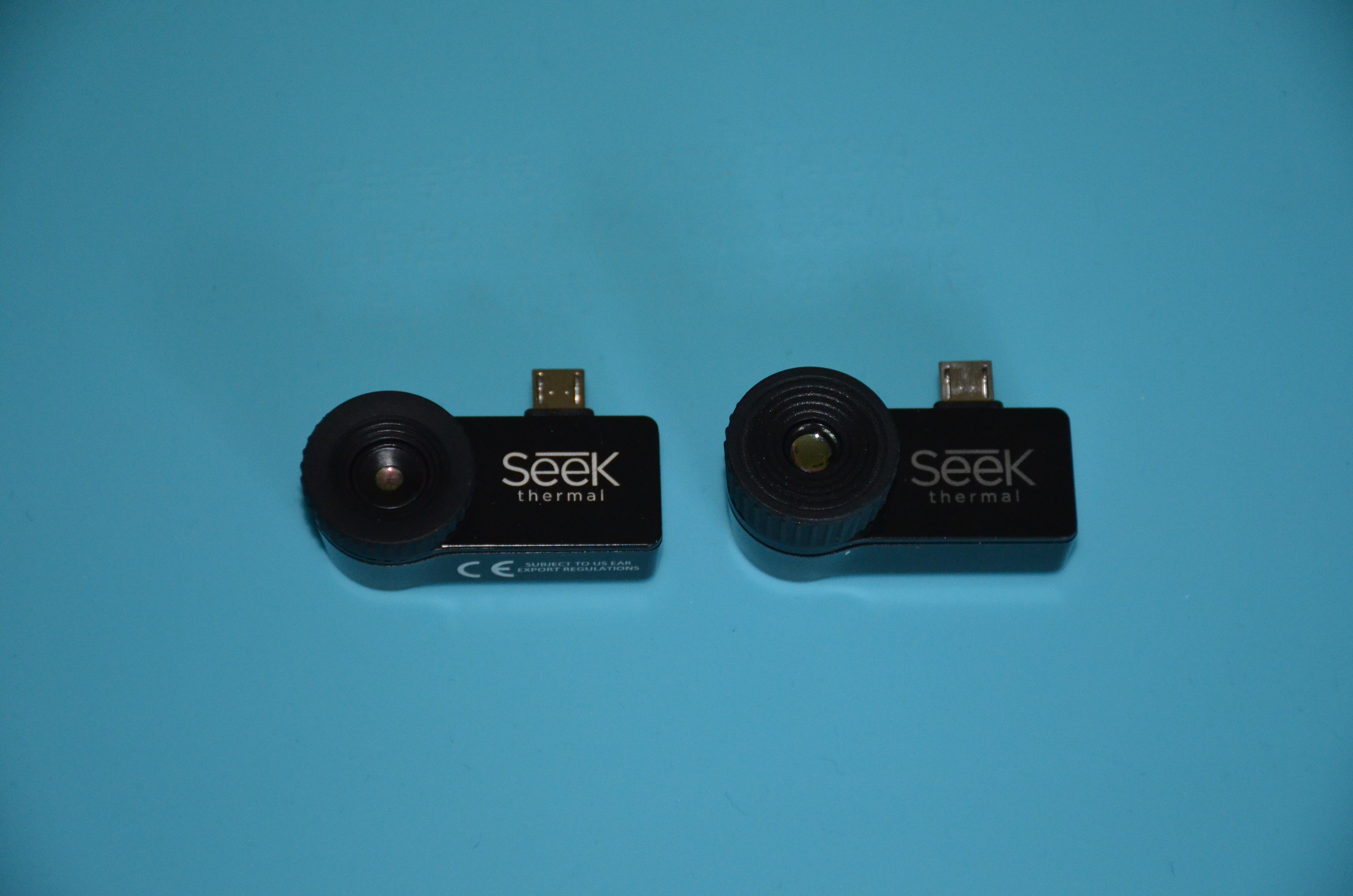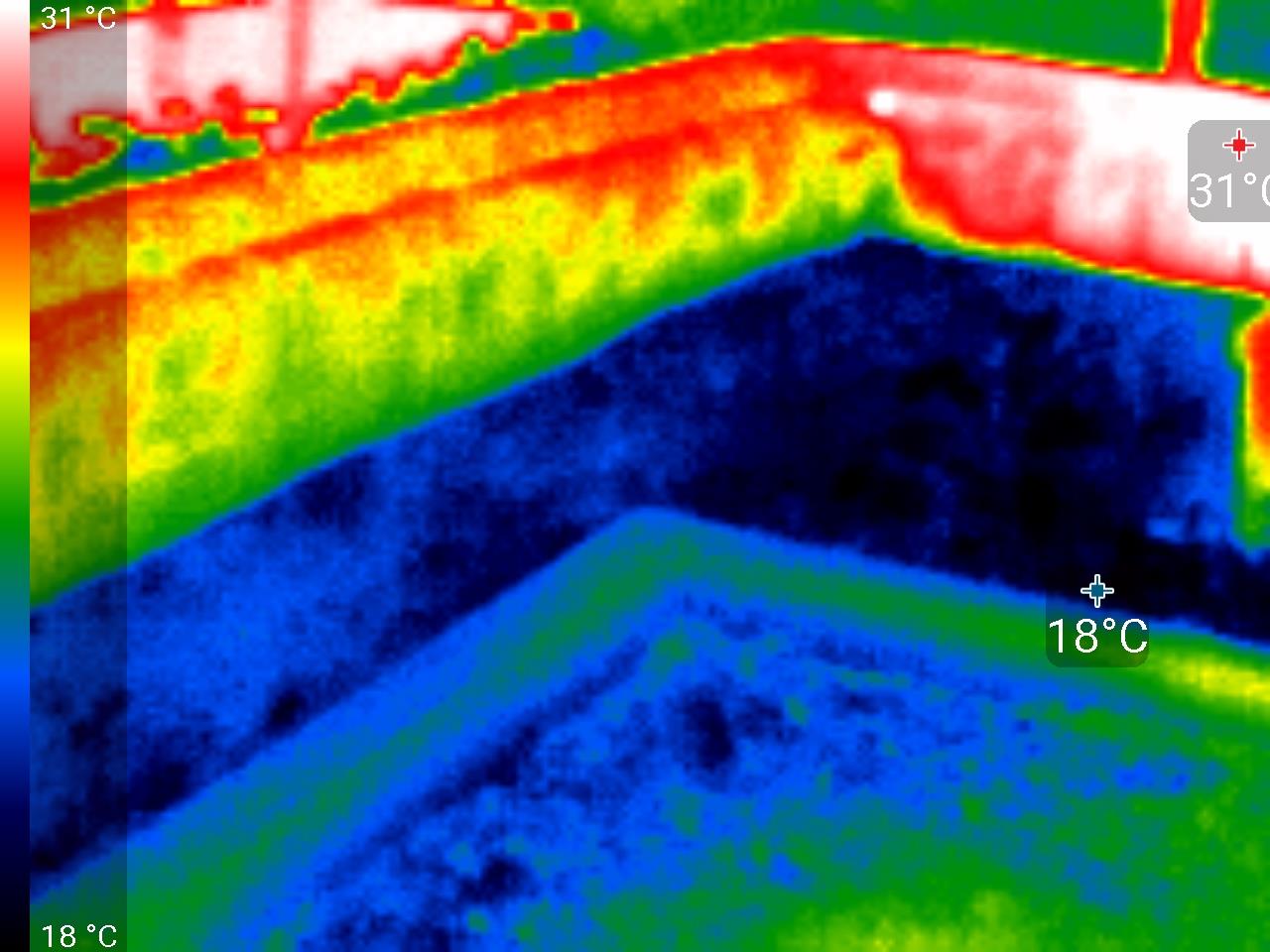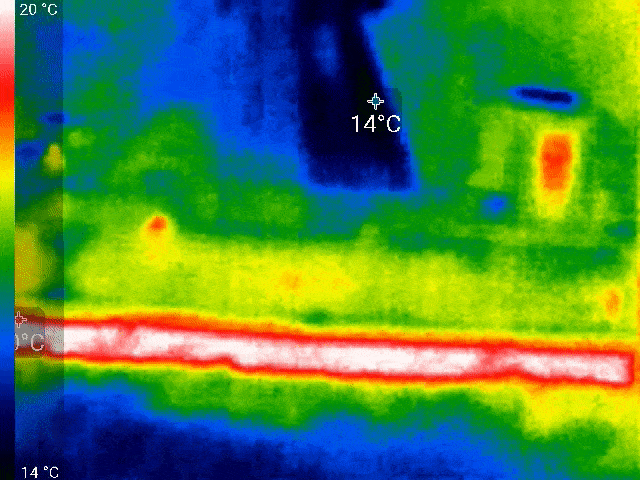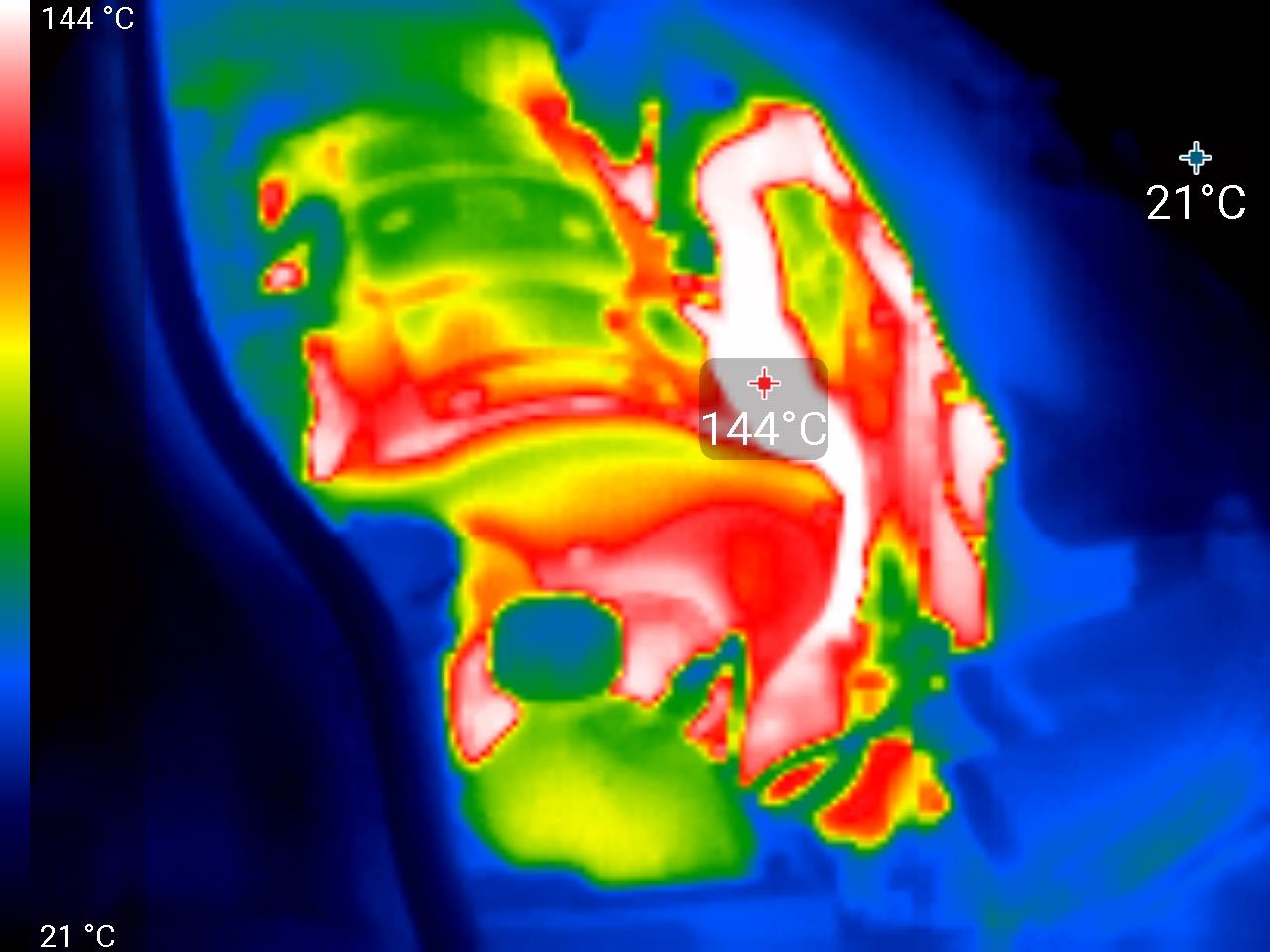Thermal imager Seek Thermal Compact
I add a review about my little assistant - the Seek Thermal Compact mobile thermal imager-set-top box. The thermal imager for smartphones and tablets will help to detect and eliminate heat or cold leaks, notice problems with electrical wiring, see places of local heating or overheating of equipment, find prey on the hunt, and so on. Seek Thermal managed to create an inexpensive and affordable compact device that connects to a smartphone or tablet, and has the full functionality of “adult” professional models.

The Seek Thermal Compact mobile thermal imager is a small external camera-set-top box for a smartphone, which provides a micro-bolometric matrix with a special LWIR lens. The thermal imager was developed in the USA and, unlike Chinese fakes, has excellent characteristics.

Main characteristics:
Brand: Seek Thermal
Model: Compact
Resolution of the thermal sensor: 206 x 156 pixels
FOV viewing angle: 36 degrees
Detection range: Up to 300 meters
Scan frequency: 9 Hz
Autofocus: Yes

The thermal imager works in the LWIR range (infrared). Conventional lenses do not transmit LWIR radiation, so for thermal imaging devices they are made from germanium (Ge). The microbolometer sensor is a matrix of miniature thin-film thermistors. The infrared radiation collected and focused on the sensor by the thermal imager lens heats the matrix elements in accordance with the temperature distribution of the observed object. Each time you turn on and during continuous operation, a regular recalibration occurs with a characteristic click.

The kit has a special case for carrying and storing the device. The case protects not only from bumps and falls, but also from moisture.

Inside there is a soft insert that protects the thermal imager from shock and other influences.

The case is compact, there is a ring in order to hang it on a keychain. It fits comfortably in your pocket.

There is a ring on the lens to adjust the image.

To connect to a smartphone or tablet, use the MicroUSB connector (or Lightning for Apple devices).

For smartphones with Type-C, conventional adapters are suitable. I recommend not to save money and take the adapter more expensive, since due to the rattling of contacts in cheap models, the thermal imager is periodically turned off. It’s better to overdo it.

To work with the device, you will need to download and install the special “Seek Thermal” application from the App Store or Google Play.

Next, connect Seek Thermal directly to your smartphone or tablet, or through the adapter.

We launch the application, give permission to access the camera, select and configure modes for ourselves.

The application has a number of settings, markers, palettes to choose from to increase the contrast of the image, as well as the ability to shoot video.

Comparison of different models of Seek Thermal
Pay attention to the different FOV angles of view (20 ° to 36 °) for different models.
The pro version of the device has a matrix with a resolution of 320 x 240 pixels, the remaining 206 x 156 pixels. The XR model has a focusable lens system, while the younger Compact has a fixed focus.

I have an old Seek Thermal Compact XR lying around, so there will be a few photos for a “live” comparison of these models (in the photo on the left - Compact XR, on the right - the updated Compact).

The main difference, in addition to cost, is the presence of a variable focal length. To adjust which is a massive rotary ring on the lens. In the photographs, the difference between the lenses of the two models is noticeable (in the photo on the left is the updated Compact, on the right is Compact XR).
Update: there was really no focus on older Compact models. The new Seek Thermal Compact model (in the article) updated the design and, nevertheless, introduced this function. Differences from the Compact XR model at least.

But for comparison, Flir One Pro (3th Gen) is one of the most expensive set-top boxes for smartphones and tablets. The bolometric matrix of this Flir One model has a total of 160 x 120 sensors (versus 206 x 156 points for Seek), and a similar FOV viewing angle: 55 x 43 ° (for Seek 36 °). And this at three times the cost than Seek.

This is a rather bulky model with a built-in battery, an additional camera of the visible range. I also use the Flir One Pro model with an adapter.

As for the operation of the thermal imager, it takes some time to familiarize yourself with the instructions and software capabilities.

Application Scenarios for the Seek Thermal Compact Thermal Imager
The problem of housing insulation has occupied humanity since the moment when our ancestors settled in caves. We can protect the room from the effects of the cold with our own hands and by eye. But how to check how well we did it? You can walk with a candle, study the direction of the drafts or fix frost on the walls. And it is possible to conduct a thermal imaging inspection of the premises using the Seek Thermal mobile thermal imager, obtaining a complete picture of the temperature difference in the space under study. But this is far from the only use of a mini thermal imager. A mobile thermal imager will help wherever you need to see heat or cold. The main application is the search and diagnosis of problems with electrical wiring, switchboard equipment, the search for communications walled up in the floor or walls, the detection of refrigerant leaks, defects in finishing work, the search for causes of drafts,
Recently, great importance has been given to thermal inspections - the type of diagnostics of building defects in country houses, cottages and city apartments, verification of wall insulation, installation of plastic windows, diagnostics of “warm floors”, heating and plumbing using a thermal imager.
In the photo there is a panel house, part of which is insulated from the outside. A similar method is used as thermal insulation for significant defects in the seams and the panels of the apartment building itself. Moreover, the use of a thermal imager can both predict defects and help determine the location of the application of additional insulation, and for diagnosing the results of insulation. Unambiguously try to find a thermal imager (or thermal inspection services) when accepting work when renting a house, during insulation, during outdoor work, and so on.

The other day I captured a thermal imager to inspect the engineering networks in the building. In addition to visual control, do not be lazy, look through the thermal imager. You can check not only the electrics and lighting (for unwanted overheating or heating where there should not be), the communications of hot and cold water supply, but also evaluate the air conditioning and ventilation systems. In the photo there are bright spots - energy-saving lamps, and also thermal traces of communications are visible.

And here the thermal insulation is clearly damaged. We will record for the next scheduled maintenance.

One of the most popular applications of the thermal imager is hunting, especially in the dark. In conditions of complex visibility, the thermal imager allows you to uniquely determine the presence of the desired animals.

For example, a thermographic image of birds.

The highlight is the thermal imager “catches” this in dynamics. Here is an excerpt from a birdwatching video. Visually, they are poorly visible against the background of grass and bushes.

The thermal imager is suitable for monitoring and troubleshooting complex machinery and equipment.
For example, it can be used to evaluate the “health” of the cooling system and the exhaust of a car engine.
In the photo, a picture of the brake disc of a car after a trip.

Heated engine (exhaust manifold in the foreground).

Side view of the engine - visible hot nozzles and a hot radiator for engine cooling.

For comparison, I cite the thermographic images of Seek Thermal Compact (left) and Compact XR (right).
Table fan.

BMW car after the trip.

Further even more interesting.
Thermographic images of Seek Thermal Compact (left), Compact XR (center) and Flir One Pro (right). In this case, the XR draws clarity due to focusing, and Flir - due to an additional optical camera.

Flir displays a picture not very honestly. He draws the image according to the results of the visible range of images. This may cause an error. Seek with a matrix 60% larger (206 x 156 versus 160 x 120 pixels) shows a more “correct” image. Additionally, you can stretch using various palettes.

On a habr you can find many applications to this thermal imager. There is also information about the components of the device ( source ).

The compact size combined with the technical characteristics of serious
stationary models make the Compact thermal imager indispensable for both home
and professional use. And given the low cost, Seek is a leader in budget models.
From July 1 to July 31, 2019, the Seek Thermal Compact thermal imager is sold at a special price with a 15% discount: 19,465 p. Use the ST Summer1 promotional code to get a discount.


The Seek Thermal Compact mobile thermal imager is a small external camera-set-top box for a smartphone, which provides a micro-bolometric matrix with a special LWIR lens. The thermal imager was developed in the USA and, unlike Chinese fakes, has excellent characteristics.

Main characteristics:
Brand: Seek Thermal
Model: Compact
Resolution of the thermal sensor: 206 x 156 pixels
FOV viewing angle: 36 degrees
Detection range: Up to 300 meters
Scan frequency: 9 Hz
Autofocus: Yes

The thermal imager works in the LWIR range (infrared). Conventional lenses do not transmit LWIR radiation, so for thermal imaging devices they are made from germanium (Ge). The microbolometer sensor is a matrix of miniature thin-film thermistors. The infrared radiation collected and focused on the sensor by the thermal imager lens heats the matrix elements in accordance with the temperature distribution of the observed object. Each time you turn on and during continuous operation, a regular recalibration occurs with a characteristic click.

The kit has a special case for carrying and storing the device. The case protects not only from bumps and falls, but also from moisture.

Inside there is a soft insert that protects the thermal imager from shock and other influences.

The case is compact, there is a ring in order to hang it on a keychain. It fits comfortably in your pocket.

There is a ring on the lens to adjust the image.

To connect to a smartphone or tablet, use the MicroUSB connector (or Lightning for Apple devices).

For smartphones with Type-C, conventional adapters are suitable. I recommend not to save money and take the adapter more expensive, since due to the rattling of contacts in cheap models, the thermal imager is periodically turned off. It’s better to overdo it.

To work with the device, you will need to download and install the special “Seek Thermal” application from the App Store or Google Play.

Next, connect Seek Thermal directly to your smartphone or tablet, or through the adapter.

We launch the application, give permission to access the camera, select and configure modes for ourselves.

The application has a number of settings, markers, palettes to choose from to increase the contrast of the image, as well as the ability to shoot video.

Comparison of different models of Seek Thermal
Pay attention to the different FOV angles of view (20 ° to 36 °) for different models.
The pro version of the device has a matrix with a resolution of 320 x 240 pixels, the remaining 206 x 156 pixels. The XR model has a focusable lens system, while the younger Compact has a fixed focus.

I have an old Seek Thermal Compact XR lying around, so there will be a few photos for a “live” comparison of these models (in the photo on the left - Compact XR, on the right - the updated Compact).

The main difference, in addition to cost, is the presence of a variable focal length. To adjust which is a massive rotary ring on the lens. In the photographs, the difference between the lenses of the two models is noticeable (in the photo on the left is the updated Compact, on the right is Compact XR).
Update: there was really no focus on older Compact models. The new Seek Thermal Compact model (in the article) updated the design and, nevertheless, introduced this function. Differences from the Compact XR model at least.

But for comparison, Flir One Pro (3th Gen) is one of the most expensive set-top boxes for smartphones and tablets. The bolometric matrix of this Flir One model has a total of 160 x 120 sensors (versus 206 x 156 points for Seek), and a similar FOV viewing angle: 55 x 43 ° (for Seek 36 °). And this at three times the cost than Seek.

This is a rather bulky model with a built-in battery, an additional camera of the visible range. I also use the Flir One Pro model with an adapter.

As for the operation of the thermal imager, it takes some time to familiarize yourself with the instructions and software capabilities.

Application Scenarios for the Seek Thermal Compact Thermal Imager
The problem of housing insulation has occupied humanity since the moment when our ancestors settled in caves. We can protect the room from the effects of the cold with our own hands and by eye. But how to check how well we did it? You can walk with a candle, study the direction of the drafts or fix frost on the walls. And it is possible to conduct a thermal imaging inspection of the premises using the Seek Thermal mobile thermal imager, obtaining a complete picture of the temperature difference in the space under study. But this is far from the only use of a mini thermal imager. A mobile thermal imager will help wherever you need to see heat or cold. The main application is the search and diagnosis of problems with electrical wiring, switchboard equipment, the search for communications walled up in the floor or walls, the detection of refrigerant leaks, defects in finishing work, the search for causes of drafts,
Recently, great importance has been given to thermal inspections - the type of diagnostics of building defects in country houses, cottages and city apartments, verification of wall insulation, installation of plastic windows, diagnostics of “warm floors”, heating and plumbing using a thermal imager.
In the photo there is a panel house, part of which is insulated from the outside. A similar method is used as thermal insulation for significant defects in the seams and the panels of the apartment building itself. Moreover, the use of a thermal imager can both predict defects and help determine the location of the application of additional insulation, and for diagnosing the results of insulation. Unambiguously try to find a thermal imager (or thermal inspection services) when accepting work when renting a house, during insulation, during outdoor work, and so on.

The other day I captured a thermal imager to inspect the engineering networks in the building. In addition to visual control, do not be lazy, look through the thermal imager. You can check not only the electrics and lighting (for unwanted overheating or heating where there should not be), the communications of hot and cold water supply, but also evaluate the air conditioning and ventilation systems. In the photo there are bright spots - energy-saving lamps, and also thermal traces of communications are visible.

And here the thermal insulation is clearly damaged. We will record for the next scheduled maintenance.

One of the most popular applications of the thermal imager is hunting, especially in the dark. In conditions of complex visibility, the thermal imager allows you to uniquely determine the presence of the desired animals.

For example, a thermographic image of birds.

The highlight is the thermal imager “catches” this in dynamics. Here is an excerpt from a birdwatching video. Visually, they are poorly visible against the background of grass and bushes.

The thermal imager is suitable for monitoring and troubleshooting complex machinery and equipment.
For example, it can be used to evaluate the “health” of the cooling system and the exhaust of a car engine.
In the photo, a picture of the brake disc of a car after a trip.

Heated engine (exhaust manifold in the foreground).

Side view of the engine - visible hot nozzles and a hot radiator for engine cooling.

For comparison, I cite the thermographic images of Seek Thermal Compact (left) and Compact XR (right).
Table fan.

BMW car after the trip.

Further even more interesting.
Thermographic images of Seek Thermal Compact (left), Compact XR (center) and Flir One Pro (right). In this case, the XR draws clarity due to focusing, and Flir - due to an additional optical camera.

Flir displays a picture not very honestly. He draws the image according to the results of the visible range of images. This may cause an error. Seek with a matrix 60% larger (206 x 156 versus 160 x 120 pixels) shows a more “correct” image. Additionally, you can stretch using various palettes.

On a habr you can find many applications to this thermal imager. There is also information about the components of the device ( source ).

The compact size combined with the technical characteristics of serious
stationary models make the Compact thermal imager indispensable for both home
and professional use. And given the low cost, Seek is a leader in budget models.
From July 1 to July 31, 2019, the Seek Thermal Compact thermal imager is sold at a special price with a 15% discount: 19,465 p. Use the ST Summer1 promotional code to get a discount.

